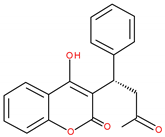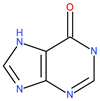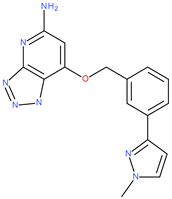Abstract
This investigation aims to assess the chemical composition and antioxidant properties of Origanum vulgare var. aureum L. essential oil (OEO). The oil was obtained with a 0.34% (v/w dried weight) yield and investigated by gas chromatography-mass spectrometry (GC–MS) analysis. The main compounds of the OEO were found to be gamma-terpinene (22.96%), para-cymene (14.72%), germacrene (11.64%), beta-trans-ocimene (9.81%), and cis-beta-ocimene (7.65%). Furthermore, individual antioxidant assays 1,1-diphenyl-2-picrylhydrazyl (DPPH) and [2,2′-azinobis(3-ethylbenzothiazoline-6-sulfonic acid) diammonium] (ABTS) radical scavenging activities and beta-carotene/linoleic acid bleaching were carried out. OEO demonstrated better scavenging effects on the DPPH (IC50 93.12 ± 0.03 μg/mL) and ABTS (IC50 27.63 ± 0.01 μg/mL) assays (significantly lower IC50 values; p ≤ 0.001) than ascorbic acid (IC50 127.39 ± 0.45 μg/mL). In the beta-carotene/linoleic acid bleaching assay, the OEO exhibited a higher Relative antioxidant activity (RAA %) (82.36 ± 0.14%) but lower compared with butylated hydroxyanisole (BHA) (100%), with no significant differences (p > 0.05) observed. According to molecular docking results, the first two main compounds of the OEO, para-cymene, and gamma-terpinene, may potentially contribute to the biological antioxidant activity of the oil by inhibiting ROS (reactive oxygen species)-producing enzymes such as lipoxygenase and xanthin oxidase. These experimental data suggest that OEO could represent a valuable new natural antioxidant source with functional properties in the food or pharmaceutical industries.
1. Introduction
Food deterioration during storage is a major environmental issue and concern of the food industry that generates over a billion tons of food waste and USD 940 billion in economic losses annually [1]. One of the leading causes of food degradation is lipid oxidation which generates off-flavors and loss of nutrients in fat-containing foods. Several techniques can be adopted to decrease auto-oxidation, such as preventing oxygen access by employing suitable packaging materials, storing food products at lower temperatures, or inactivating enzymes catalyzing oxidation [2]. However, these methods are not always applicable or economic from nutritional and technological points of view [3]. Therefore, using food antioxidants, especially synthetic ones, has become indispensable in prolonging the shelf-life of foodstuffs.
The modern food consumer does not perceive food as basic nutrition alone but also for the health benefits it can generate. Furthermore, the suspicions regarding the harmful effects on human health of synthetic antioxidants such as gallic acid esters (e.g., propyl gallate, octyl gallate, and dodecyl gallate), butylhydroxytoluene (BHT) or butylated hydroxyanisole (BHA) [4,5,6] have led to increased consumer demands for minimally processed foods with clean, easy-to-read labels and long shelf lives. Consequently, in the last few decades, the food industry companies were urged to access natural extracts as a source of food additives to preserve food safety without harming consumers’ health. Through their extracts, especially essential oils (EO), aromatic and medicinal plants are a valuable source of biologically active compounds [7,8,9]. Moreover, recent investigations have revealed that EOs possess promising biological properties, such as antioxidant, antimicrobial, and antiviral effects [8,10,11,12], recommending them as an alternative to synthetic food additives.
The Origanum (Lamiaceae) genus is an annual, perennial, and shrubby herb extensively found in the Mediterranean region [13]. Origanum is classified into three groups, ten sections and thirty-eight species (six subspecies and seventeen hybrids) [14]. Two commercially important varieties, Origanum vulgare subsp. hirtum (Greek oregano) and Origanum onites (Turkish oregano) are also among the most marketed and used spice plants [14,15,16]. The flavoring properties of oregano are mainly associated with its aromatic substances, especially its EO [14,17]. Carvacrol is the main volatile oil compound in oregano herbs, responsible for the characteristic "oregano" scent. Other compounds that dominate the EOs of genus members are thymol, para-cymene, and gamma-terpinene. Several investigations reported that oregano oil has a powerful antimicrobial effect against bacteria, yeast, and fungi. Furthermore, EOs extracted from Origanum sp. are known to possess cytotoxic activities against cancer cells, to protect cells from reactive oxygen species (ROS) degradation, and to generate an antioxidant and anti-inflammatory biological effect via key enzymes (lipoxygenase) inhibition [18,19]. Also, oregano oil possesses antioxidant properties effective in slowing color loss and lipid oxidation in fatty foods and scavenging free radicals [20,21,22].
However, some genus members remain insufficiently studied, such as Origanum vulgare var. aureum L., for which scientific literature provides insufficient data about its EO antioxidant properties. Furthermore, the probable mechanism of action against lipid oxidation of Origanum vulgare var. aureum essential oil (OEO) has not been investigated previously. Considering the background, we aimed to investigate the chemical composition and evaluate the antioxidant properties of OEO. Moreover, we aimed to analyze in silico the antioxidant biological effects based on the inhibitory capacity of OEO components against key enzymes involved in producing reactive oxygen species utilizing a molecular docking-based approach.
2. Materials and Methods
2.1. Raw Material and Chemicals
O. vulgare var. aureum L. stems, leaves, and flowers were harvested at full blossom from the village of Ludești de Jos, Hunedoara County (Romania) (45°05′ N 22°19′ E) in July 2021. A voucher specimen (VSNH.BUASTM-93/2) was taken in the Herbarium of the Faculty of Agronomy, University of Life Sciences “King Michael I” from Timișoara. Anhydrous sodium sulphate (Na2SO4), potassium persulfate (K2S2O8), hexane, methanol, chloroform, ethanol, and ascorbic acid were obtained from Sigma-Aldrich (Germany). In addition, 1,1-diphenyl-2-picrylhydrazyl radical (DPPH), β-carotene, 2,2′-azinobis (3-ethylbenzothiazoline-6-sulfonic acid) diammonium salt (ABTS), C8-C20 alkane standard mixture and butylated hydroxyanisole (BHA) were obtained from Merck Company (Darmstadt, Germany).
2.2. Extraction of OEO
The collected specimens were air dried in the dark at laboratory temperature (end of 2021/beginning of 2022) and cut into ca. 1.5 cm long parts before the distillation. OEO was obtained by steam distillation operating a modified Craveiro-type apparatus described previously by Jianu et al. [23]. After extraction, the OEO was collected, dried over anhydrous Na2SO4, and kept in amber-sealed vials (−18 °C) for future analysis (yielding 0.34% v/w).
2.3. Gas Chromatography-Mass Spectrometry Analysis
This assay was performed on a gas chromatograph (HP6890 Gas-Chromatograph) coupled with a mass spectrometer (HP5973 Mass Spectrometer). The oil sample was diluted 1:1000 in hexane before 1 μL was injected in a splitless mode. The sample passed through a capillary Br-5MS column with a 5% Phenyl-arylene-95% Dimethylpolysiloxane phase; the column was 30 m long, with a 0.25 mm internal diameter, 0.25 μm film thickness (Bruker, Billerica, MA, USA), with a helium flow rate of 1 mL/min. The column was heated at a program starting from 50 °C to 300 °C at 6 °C/min, where the final hold was 5 min. The MS Quad temperature was set at 150 °C, and the ionization energy was 70 eV. After 3 min, solvent delay started scanning compounds between 50 to 550 amu. The resulting peaks represented compounds found in the oil sample and were identified by comparing their mass spectra with the ones from the NIST2.0 library (USA National Institute of Science and Technology software, Version NIST 2.0 library). The percentage area of each compound was calculated by dividing its area by the total area and multiplying by 100. Furthermore, their retention indices (RIs) were calculated using the linear equation obtained from a calibration curve of a standard alkane C8-C20 and then compared to previously published values in the literature to confirm the identity of the identified components [24].
2.4. Antioxidant Activity by 1,1-Diphenyl-2-Picrylhydrazyl (DPPH) Radical Scavenging Assay
A DPPH radical scavenging assay was conducted using the stable radical DPPH [25]. A methanolic solution of DPPH radical at different concentrations, from 1.5 mg/mL to 2.93 μg/mL, was prepared. A ratio of 1:10 DPPH/sample (v/v) was plated in triplicates on 96 well plates and incubated in the dark at room temperature. After a 30 min reaction period, absorbances were registered at 515 nm on a spectrophotometer Tecan i-control, 1.10.4.0 infinite 200Pro. BHA and ascorbic acid were used as positive controls. The following equation computed the DPPH scavenging activity: % DPPH scavenging activity = (Ablank − AOEO)·100/Ablank, where: Ablank and AOEO are the absorbances of the control and the tested oil. IC50 (μg/L) value, defined as the concentration of oil required to scavenge the formation of 50% of free radicals, was calculated using the BioDataFit 1.02 program (Chang Broscience Inc, Castro Valley, CA, USA) and expressed as means ± standard deviation (SD) of three independent experiments.
2.5. Antioxidant Activity by [2,2′-Azinobis(3-Ethylbenzothiazoline-6-Sulfonic Acid) Diammonium] (ABTS) Radical Scavenging Assay
ABTS radical scavenging activity was conducted using the method previously reported by Rădulescul et al. (2021) [26] with a slight modification. Briefly, ABTS (7.0 mM) and K2S2O8 (2.5 mM) were added to an amber-colored bottle for the preparation of ABTS cation (ABTS+) and kept in the dark for 14 h at 21 °C. First, the ABTS+ solution was diluted in ethanol (approximately 1:80) to an absorbance of 0.700 ± 0.035 at 734 nm [27]. Subsequently, 100 μL of the OEO in methanol, with various concentrations (from 1.5 mg/mL to 9.3 μg/mL), were mixed with 1 mL of ABTS+ solution. The absorbances were measured at 734 nm after 30 min (at 21 °C in the dark). BHA and ascorbic acid served as positive controls. Finally, the ABTS scavenging activity was analyzed by IC50 (μg/L) value as the inhibitory concentration of the OEO required to scavenge the formation of 50% of ABTS, expressed as means ± standard deviation (SD) of three independent experiments.
2.6. Beta-Carotene/Linoleic Acid Bleaching Assay
The β-Carotene/Linoleic acid bleaching test was assessed employing the method described by Rădulescu et al. (2021) [26]. First, a stock solution of β-carotene was obtained by dissolving 0.5 mg β-carotene in 1 mL of CHCl3, 25 μL linoleic acid, and 200 mg Tween 40. A vacuum rotary evaporator removed chloroform under a vacuum (at 40 °C for 5 min), and then 100 mL of distilled water was added to the residue to form a transparent yellowish emulsion. Next, 350 μL of oil in methanol (2 mg/mL) was stirred exhaustively with 2.5 mL of β-carotene stock solution and incubated for 48 h at 21 °C. The same methodology was repeated for the synthetic antioxidant (BHA) serving as positive control and a blank sample (350 μL of methanol). After this incubation period, the absorbance of the samples was read at 490 nm in three independent experiments. The following equation computed the Relative Antioxidant Activity (RAA %): RAA = AOEO/ABHA, where AOEO and ABHA are the absorption of OEO and the absorbance of the BHA, respectively.
2.7. In Silico Prediction of Bioactivity and Molecular Docking Studies
Molecular docking simulations were performed using a method previously described [23]. In brief, docking targets were optimized using the 3D crystallographic structure of proteins available from the RCSB Protein Data Bank [28] (Table 1). The 38 OEO components were downloaded from the Pubchem repository [29] as SDF files and were later converted to PDBQT files using Autodocktools [30]. The PyRx v0.8 virtual screening software (The Scripps Research Institute, La Jolla, CA, USA) and Vina’s embedded scoring function [31] were used for molecular docking. Each input molecular structure’s target protein was docked with the default number of conformers (eight per each ligand structure). The structure of each protein native ligand (NL) (Table 1) was retrieved from their respective PDB file and converted to the PDBQT format as described above. In order to validate our protocol, the calculated root means square deviation (RMSD) between predicted and actual native ligand docking conformation for every case could not exceed a 2 Å threshold. The coordinates and size of the docking grid box were selected to match the active binding domain (Table 1) perfectly. The software generated ΔG binding energy values (kcal/mol) as docking scores for each docked molecule. Protein-ligand binding interactions were also investigated using Accelrys Discovery Studio 4.1. (Dassault Systems BIOVIA, San Diego, CA, USA).

Table 1.
Docking parameters used for the in silico evaluation of the 38 OEO components.
2.8. Statistical Analysis
Conventional statistical methods were employed to compute the mean ± standard deviation (SD) of three independent experiments carried out separately for the antioxidant activity assays. In addition, a post hoc test (Tukey) was applied to compare the significant differences between the mean values obtained from the antioxidant activity measurements, with a significance of 0.05 (p < 0.05). Analysis was performed using the IBM SPSS 25.0 package (SPSS Inc., Chicago, IL, USA).
3. Results and Discussion
3.1. OEO Yield and Chemical Composition
A greenish-yellow oil with a pungent smell was obtained from dry O. vulgare var. aureum L. (stems, leaves, and flowers), with a 0.34% (v/w) yield. Our results agree with those mentioned in the literature, which record yields of obtaining EOs from different oregano species as lower than 1% [32].
Table 2 summarizes the chemical compositions of the EO isolated from O. vulgare var. aureum L. by steam distillation. The GC-MS analysis identified 38 compounds in the analyzed sample (Figure 1), with gamma-terpinene (22.96%), para-cymene (14.72%), germacrene (11.64%), beta-trans-ocimene (9.81%), and cis-beta-ocimene (7.65%) as main compounds of the oil (Table 2). In addition, beta-linalool (3.61%), isothymol methyl ether (3.34%), beta-phellandrene (2.44%), beta-caryophyllene (2.35%), alpha-terpinene (1.84%), beta-cadinene (1.78%), alpha-farnesene (1.55%), (-)-spathulenol (1.35%), beta-myrcene (1.31%) and alpha-himalachene (1.29%) were identified in smaller quantities.

Table 2.
Chemical composition of OEO as determined by GC-MS analysis.
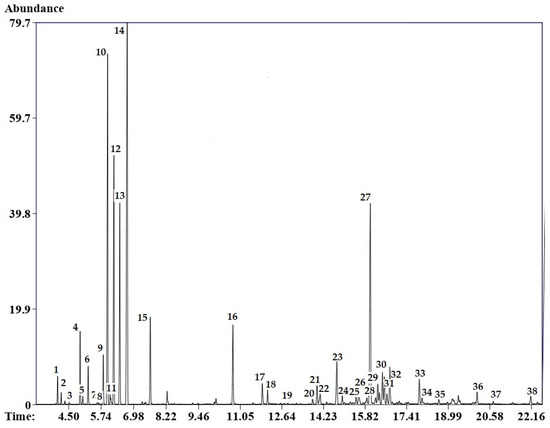
Figure 1.
Gas chromatogram of OEO from western Romania.
Popa et al. [33] reported linalool (26.54%), para-cymene (20.81%), and gamma-terpinene (13.73%) as the major compounds for the oil isolated from Romanian O. aureum. Furthermore, high contents of linalool (25.5%), para-cymene (20.7%), and gamma-terpinene (15.66%) were also documented for the golden oregano oil by Moisa et al. [34]. In contrast, the oil obtained from Polish O. aureum contained mainly cis-sabinene hydrate (18.7%), germacrene D (16.5%), and thymol (12.2%), respectively [35]. The variability of oil content and the chemical composition of the oregano herbs EOs is strongly dependent on the environment and local conditions of the plants, climatic conditions, and geographical distribution of the plant collections, as previously documented [35,36,37,38].
3.2. Assessment of Antioxidant Activity
It is well-known that free radicals initiate the process of lipid peroxidation and the propagation of the chain of radical structures. Therefore, several methods have been developed to determine compounds’ antioxidant properties [39,40,41]. For example, 2,2-diphenyl-1-picrylhydrazyl (DPPH) and 2,2′-azino-bis(3-ethylbenzthiazoline-6-sulfonic acid) radical (ABTS) assays are two spectrophotometer techniques widely employed for assessing the antioxidant properties of natural extracts. Briefly, the DPPH method is based on reducing the purple DPPH radical to 1,1-diphenyl-2-picryl-hydrazine (DPPH-H). In contrast, the ABTS method implicates the reduction or radical scavenging of a blue/green ABTS radical to a colorless sulfonic acid [42]. Butylated hydroxyanisole (BHA) and ascorbic acid were used as the positive control. The IC50 values were computed employing BioDataFit 1.02 program (Chang Broscience Inc, Castro Valley, CA, USA). In our study, OEO reduced the stable free radical DPPH with an IC50 value of 93.12 ± 0.03 μg/mL (Table 3). Tukey’s test shows that the OEO’s DPPH values are significantly lower than ascorbic acid (p < 0.01). Previously, Popa et al. documented low antioxidant capacity for Romanian O. vulgare var. aureum volatile oil, with a 58.18 ± 0.07% inhibition [33]. Comparable effects were reported by Moisa et al. for oils isolated from O. vulgare var. aureum leaves and flowers with 63.1 ± 0.7% and 66.4 ± 2.23% inhibitions [34]. Better results were documented for oils extracted from O. vulgare var. aureum stems and whole plant, respectively, with inhibitions ranging between 80.3 ± 0.01% to 88.6 ± 0.1% [34]. However, because of the various modes of result expression used in different studies, directly comparing our findings with those reported in the literature is difficult. Nevertheless, the DPPH radical scavenging ability registered for the studied OEO is in accord with those previously described for O. vulgare (46.66–97.61 μg/mL), Poliomintha longiflora (83.70 ± 4.12 μg/mL), O. onites L. (116.74–132.93 μg/mL) and O. syriacum (91.45 ± 2.30 μg/mL) EOs [43,44,45,46].

Table 3.
The antioxidant activity of essential oil extracted from O. vulgare var. aureum.
In the ABTS assay, OEO exhibited a good ability to scavenge the ABTS radical (IC50 27.63 ± 0.01 μg/mL) (Table 3), significantly more potent (p < 0.01) than standard ascorbic acid (IC50 35.89 ± 0.05 μg/mL) according to the Tukey’s test. In contrast, BHA revealed significantly (p < 0.001) higher antioxidant capability (IC50 8.71 ± 0.01 μg/mL) compared to OEO and ascorbic acid. Nevertheless, our results reveal that OEO was more effective in scavenging ABTS radicals than other oregano species: O. tyttanthum, O. compactum, O. vulgare, and L. graveolens [47,48,49,50].
Previously published research investigating the DPPH and reactive oxygen species scavenging capability of different extracts discovered that these extracts have similar scavenging performance in both cases [51,52]. This is to be expected, given that it is dependent on the extract components’ capacity to reduce free radicals. Based on this, OEO could be a good source of antioxidants that can also quench endogenous reactive oxygen species.
The beta-carotene/linoleic acid bleaching assay is based on the discoloration of beta-carotene determined by its reaction with the radicals resulting from the oxidation of linoleic acid in an emulsion. The presence of an antioxidant can delay the rate of beta-carotene discoloration. Table 3 displays the inhibition of beta-carotene bleaching by the OEO and the positive control used (BHA). In the case of the beta-carotene-linoleic acid bleaching assay, OEO was able to inhibit the linoleic acid oxidation (82.36 ± 0.14%) effectively but lower than BHA (100%) (p > 0.05). No previous investigations were documented concerning OEO activity in the beta-carotene/linoleic acid system to allow us to make direct comparisons.
3.3. In Silico Prediction of the Mechanism by Molecular Docking Analysis
In recent years, computer simulation methods such as molecular docking and molecular dynamics simulation have been widely used to study structure-function relationships and interaction mechanisms [53,54].
The OEO’s potential protein-targeted antioxidant effect was evaluated using molecular docking. The obtained docking scores for the 38 OEO components are depicted in Table 4.

Table 4.
Docking scores for compounds 1–38 (binding energy, kcal/mol); compounds with better docking scores than the target native ligand score is highlighted.
Our in silico-based method aimed to identify protein targets that can be inhibited by multiple components of our OEO or, at the very least, by the EO’s major constituents. In order to achieve this goal, all 38 OEO components were investigated in silico for their inhibitory potential against proteins involved in producing reactive oxygen species (ROS) [55]. The proteins selected for the docking-based virtual screening of the OEO components were Lipoxygenase, CYP2C9, NADPH-oxidase, Xanthine oxidase, and Myeloperoxidase. Docking scores show that of the five investigated proteins, two cases stand out (lipoxygenase—1N8Q and xanthine oxidase—3NRZ), where several components recorded the same or better docking scores than the respective protein’s NL score. However, in potentially assessing a biological effect of a multicomponent mixture such as the present OEO, one must consider the quantity of each molecule in that mixture.
Figuring out correlations between docking scores is challenging since every protein has distinct binding site features, and native ligands yield different docking scores, resulting in varying control values for each score set. To compensate for these drawbacks, we determined each docking score as a percentage of its corresponding native ligand’s score (considered 100%). These percentages were illustrated as a radar chart, with the scores for every compound being indicated by plot lines while the protein targets formed the chart’s corners. Compounds with a calculated percentage of 10% or below were all assigned a 10% value because positive ∆G values would give negative percentages, and the centre of the chart would become crowded and unintelligible. When a chart plot line stretches toward a specific protein target corner, this would indicate that the oil components scored close to or higher than that protein’s NL. The final result should reveal the most likely targeted protein by the EO’s constituents.
Given that a particular compound may have excellent docking scores, but only a small quantity of that molecule is contained in the volatile oil, we first plotted the components that exceed 1% of the oil content (Figure 2A). Aside from a few compounds, the same trend can be seen in this figure, where most constituents show higher affinity towards the same two proteins (lipoxygenase—1N8Q and xanthine oxidase—3NRZ) where compounds registered higher docking scores than the native ligands used as positive controls in this setting. If further compounds are removed from the same chart so that only major components that exceed a 5% weight content of the OEO remain, the trend, as mentioned earlier, becomes more visible. Aside from compound 27 (Germacrene D), which performed poorly against all five proteins, compounds 10 (para-cymene) and 14 (gamma-terpinene) stand out as the most abundant OEO components that also performed better than the native ligands when docked in both lipoxygenase (1N8Q) and xanthine oxidase (3NRZ). It was previously demonstrated that para-cymene has antinociceptive and anti-inflammatory activity associated with lipoxygenase inhibition [56]. Another study investigating the antioxidant activity of thyme oils found that the EO’s lipoxygenase inhibition was primarily due to thymol, para-cymene, and linalool [57]. Similarly, gamma-terpinene was previously reported as an in vitro lipoxygenase inhibitor [58]. Given their highly similar structures, except for para-cymene having an aromatic ring and gamma-terpinene having a cyclohexadiene ring, both compounds exhibit a similar binding pattern within the lipoxygenase binding domain near the iron site, where both compounds interact through multiple hydrophobic interactions with the surrounding amino acids (Figure 3).
No relevant literature is available regarding the direct inhibition activity of para-cymene against xanthine oxidase. However, in the case of gamma-terpinene, a study investigating the antioxidant and xanthine oxidase inhibitory activity of various sunflower essential oils discovered the monoterpene, as mentioned above, as one of the EO’s major constituents. According to a Pearson correlation analysis, gamma-terpinene was one of the constituents associated with antioxidant and anti-xanthine oxidase activity [59]. Similar to the previous case, both compounds exhibit nearly the same conformation in the active domain of xanthine oxidase, interacting with the same amino acids via hydrophobic interactions. The binding patterns shown by both compounds are depicted in Figure 4. Given that six compounds scored higher than the co-crystallized ligand (the endogenous hypoxanthine) in the case of xanthine oxidase, five of which are major components of OEO, accounting for approximately half of the OEO weight content, we can easily predict that the oil could have a significant inhibitory activity towards xanthine oxidase.
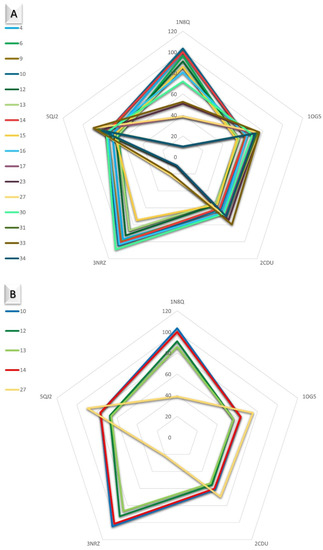
Figure 2.
Graphical representation of docking scores related to antioxidant protein targets, corresponding to the components above 1% of the OEO content (A) and OEO constituents above 5% of the OEO content (B) (representing above 65% of the volatile oil); lines are generated for each compound based on the docking scores calculated for each target protein as a percentage of the NL’s docking score used as the positive control (100%); the lines and are plotted as series in a radar chart, where the proteins represent the corners of the chart.
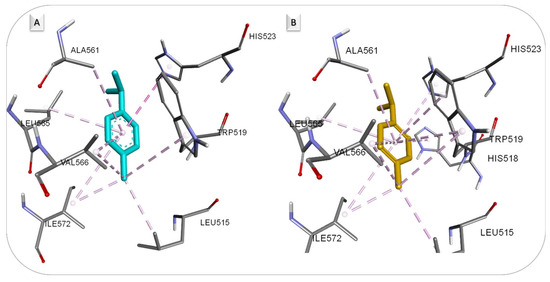
Figure 3.
Lipoxygenase (1N8Q) structure in complex with docked compound (A) para-cymene (cyan) and (B) gamma-terpinene (gold) with interacting amino acids (grey sticks) via hydrophobic interactions (pink-dotted lines). Interatomic length between interacting atoms varied between 3.53–5.63 Å.
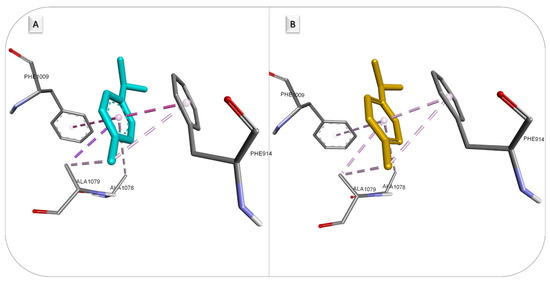
Figure 4.
Xanthine oxidase (3NRZ) structure in complex with docked compound (A) para-cymene (cyan) and (B) gamma-terpinene (gold) with interacting amino acids (grey sticks) via hydrophobic interactions (pink/purple-dotted lines). Interatomic length between interacting atoms varied between 3.61–5.21 Å.
4. Conclusions
The present investigation demonstrated that OEO revealed better antioxidant properties (significantly lower IC50 values; p ≤ 0.001) than ascorbic acid in vitro assays, such as DPPH and ABTS radical scavenging. Furthermore, according to molecular docking results, the first two major components of the volatile oil, para-cymene and gamma-terpinene, may contribute to the EO’s biological antioxidant activity by inhibiting ROS-producing enzymes such as lipoxygenase and xanthin oxidase. Due to the effective antioxidant activity recorded by OEO, it can represent a new natural source of antioxidants with potential applications in the food or pharmaceutical industry. However, further investigations are needed to elucidate the mechanism of action against oxidation reactions and to establish the safety of usage doses.
Author Contributions
Conceptualization and methodology, C.J., C.Ș. and M.M.; investigation, G.B., A.T.L.-G., R.G.R., I.D., A.M., M.M. and M.R.; statistical analysis, A.T.C.; writing—original draft preparation, C.J., G.B., R.G.R. and C.Ș.; writing—review and editing, C.J., M.R. and M.M. All authors have read and agreed to the published version of the manuscript.
Funding
This research received no external funding.
Institutional Review Board Statement
Not applicable.
Informed Consent Statement
Not applicable.
Data Availability Statement
The data published in this research are available on request from the first author and corresponding authors.
Acknowledgments
This paper is published from the own funds of the University of Life Sciences “King Michael I” from Timisoara.
Conflicts of Interest
The authors declare no conflict of interest.
References
- FAO. Members Call for Action against Food Loss and Waste in the World’s Hungriest Region—Asia and the Pacific. 2021. Available online: http://www.fao.org/asiapacific/news/detail-events/en/c/1403168/ (accessed on 11 December 2022).
- Dorman, H.; Peltoketo, A.; Hiltunen, R.; Tikkanen, M. Characterisation of the antioxidant properties of de-odourised aqueous extracts from selected Lamiaceae herbs. Food Chem. 2003, 83, 255–262. [Google Scholar] [CrossRef]
- Viuda-Martos, M.; Ruiz Navajas, Y.; Sánchez Zapata, E.; Fernández-López, J.; Pérez-Álvarez, J.A. Antioxidant activity of essential oils of five spice plants widely used in a Mediterranean diet. Flavour Fragr. J. 2010, 25, 13–19. [Google Scholar] [CrossRef]
- Park, S.; Lee, J.-Y.; Lim, W.; You, S.; Song, G. Butylated hydroxyanisole exerts neurotoxic effects by promoting cytosolic calcium accumulation and endoplasmic reticulum stress in astrocytes. J. Agric. Food Chem. 2019, 67, 9618–9629. [Google Scholar] [CrossRef] [PubMed]
- Liang, X.; Zhao, Y.; Liu, W.; Li, Z.; Souders, C.L., II; Martyniuk, C.J. Butylated hydroxytoluene induces hyperactivity and alters dopamine-related gene expression in larval zebrafish (Danio rerio). Environ. Pollut. 2020, 257, 113624. [Google Scholar] [CrossRef] [PubMed]
- Ham, J.; Lim, W.; Park, S.; Bae, H.; You, S.; Song, G. Synthetic phenolic antioxidant propyl gallate induces male infertility through disruption of calcium homeostasis and mitochondrial function. Environ. Pollut. 2019, 248, 845–856. [Google Scholar] [CrossRef] [PubMed]
- Ashok, B.; Hariram, N.; Siengchin, S.; Rajulu, A.V. Modification of tamarind fruit shell powder with in situ generated copper nanoparticles by single step hydrothermal method. J. Bioresour. Bioprod. 2020, 5, 180–185. [Google Scholar] [CrossRef]
- Tagnaout, I.; Zerkani, H.; Bencheikh, N.; Amalich, S.; Bouhrim, M.; Mothana, R.A.; Alhuzani, M.R.; Bouharroud, R.; Hano, C.; Zair, T. Chemical Composition, Antioxidants, Antibacterial, and Insecticidal Activities of Origanum elongatum (Bonnet) Emberger & Maire Aerial Part Essential Oil from Morocco. Antibiotics 2023, 12, 174. [Google Scholar] [CrossRef] [PubMed]
- Yuan, Y.; Sun, J.; Song, Y.; Raka, R.N.; Xiang, J.; Wu, H.; Xiao, J.; Jin, J.; Hui, X. Antibacterial activity of oregano essential oils against Streptococcus mutans in vitro and analysis of active components. BMC Complement. Med. Ther. 2023, 23, 61. [Google Scholar] [CrossRef] [PubMed]
- Mancianti, F.; Ebani, V.V. Biological activity of essential oils. Molecules 2020, 25, 678. [Google Scholar] [CrossRef]
- Saeed, K.; Pasha, I.; Jahangir Chughtai, M.F.; Ali, Z.; Bukhari, H.; Zuhair, M. Application of essential oils in food industry: Challenges and innovation. J. Essent. Oil Res. 2022, 34, 97–110. [Google Scholar] [CrossRef]
- Kačániová, M.; Galovičová, L.; Ivanišová, E.; Vukovic, N.L.; Štefániková, J.; Valková, V.; Borotová, P.; Žiarovská, J.; Terentjeva, M.; Felšöciová, S. Antioxidant, antimicrobial and antibiofilm activity of coriander (Coriandrum sativum L.) essential oil for its application in foods. Foods 2020, 9, 282. [Google Scholar] [CrossRef]
- Pezzani, R.; Vitalini, S.; Iriti, M. Bioactivities of Origanum vulgare L.: An update. Phytochem. Rev. 2017, 16, 1253–1268. [Google Scholar] [CrossRef]
- Skoula, M.; Harborne, J.B. The taxonomy and chemistry of Origanum. In Oregano: The genera Origanum and Lippia; CRC Press: Boca Raton, FL, USA, 2002; Volume 67. [Google Scholar]
- Shayista, C.; Zahoor, A.K.; Phalestine, S. Medicinal importance of genus Origanum: A review. J. Pharmacogn. Phytother. 2013, 5, 170–177. [Google Scholar]
- Verma, R.S.; Padalia, R.C.; Chauhan, A. Analysis of the hydrosol aroma of Indian oregano. Med. Aromat. Plants 2012, 1, 112. [Google Scholar] [CrossRef]
- Yan, F.; Azizi, A.; Janke, S.; Schwarz, M.; Zeller, S.; Honermeier, B. Antioxidant capacity variation in the oregano (Origanum vulgare L.) collection of the German National Genebank. Ind. Crops Prod. 2016, 92, 19–25. [Google Scholar] [CrossRef]
- Karioti, A.; Milošević-Ifantis, T.; Pachopos, N.; Niryiannaki, N.; Hadjipavlou-Litina, D.; Skaltsa, H. Antioxidant, anti-inflammatory potential and chemical constituents of Origanum dubium Boiss., growing wild in Cyprus. J. Enzym. Inhib. Med. Chem. 2015, 30, 38–43. [Google Scholar] [CrossRef] [PubMed]
- Coccimiglio, J.; Alipour, M.; Jiang, Z.H.; Gottardo, C.; Suntres, Z. Antioxidant, Antibacterial, and Cytotoxic Activities of the Ethanolic Origanum vulgare Extract and Its Major Constituents. Oxidative Med. Cell. Longev. 2016, 2016, 1404505. [Google Scholar] [CrossRef]
- Castilho, P.C.; Savluchinske-Feio, S.; Weinhold, T.S.; Gouveia, S.C. Evaluation of the antimicrobial and antioxidant activities of essential oils, extracts and their main components from oregano from Madeira Island, Portugal. Food Control 2012, 23, 552–558. [Google Scholar] [CrossRef]
- Şahin, F.; Güllüce, M.; Daferera, D.; Sökmen, A.; Sökmen, M.; Polissiou, M.; Agar, G.; Özer, H. Biological activities of the essential oils and methanol extract of Origanum vulgare ssp. vulgare in the Eastern Anatolia region of Turkey. Food Control 2004, 15, 549–557. [Google Scholar] [CrossRef]
- Botsoglou, N.; Florou-Paneri, P.; Christaki, E.; Fletouris, D.; Spais, A. Effect of dietary oregano essential oil on performance of chickens and on iron-induced lipid oxidation of breast, thigh and abdominal fat tissues. Br. Poult. Sci. 2002, 43, 223–230. [Google Scholar] [CrossRef]
- Jianu, C.; Rusu, L.-C.; Muntean, I.; Cocan, I.; Lukinich-Gruia, A.T.; Goleț, I.; Horhat, D.; Mioc, M.; Mioc, A.; Șoica, C.; et al. In Vitro and In Silico Evaluation of the Antimicrobial and Antioxidant Potential of Thymus pulegioides Essential Oil. Antioxidants 2022, 11, 2472. [Google Scholar] [CrossRef]
- Adams, R.P. Identification of Essential Oil Components by Gas Chromatography/Mass Spectrometry; Allured Publishing Corporation: Carol Stream, IL, USA, 2007; Volume 456. [Google Scholar]
- Jianu, C.; Mihail, R.; Muntean, S.G.; Pop, G.; Daliborca, C.V.; Horhat, F.G.; Nitu, R. Composition and antioxidant capacity of essential oils obtained from Thymus vulgaris, Thymus pannonicus and Satureja montana grown in Western Romania. Rev. Chim. 2015, 66, 2157–2160. [Google Scholar]
- Rădulescu, M.; Jianu, C.; Lukinich-Gruia, A.T.; Mioc, M.; Mioc, A.; Șoica, C.; Stana, L.G. Chemical composition, in vitro and in silico antioxidant potential of Melissa officinalis subsp. officinalis essential oil. Antioxidants 2021, 10, 1081. [Google Scholar] [CrossRef]
- Xin, X.; Fan, R.; Gong, Y.; Yuan, F.; Gao, Y. On-line HPLC-ABTS•+ evaluation and HPLC-MS n identification of bioactive compounds in hot pepper peel residues. Eur. Food Res. Technol. 2014, 238, 837–844. [Google Scholar] [CrossRef]
- Berman, H.M.; Westbrook, J.; Feng, Z.; Gilliland, G.; Bhat, T.N.; Weissig, H.; Shindyalov, I.N.; Bourne, P.E. The Protein Data Bank. Nucleic Acids Res. 2000, 28, 235–242. [Google Scholar] [CrossRef]
- Kim, S.; Chen, J.; Cheng, T.; Gindulyte, A.; He, J.; He, S.; Li, Q.; Shoemaker, B.A.; Thiessen, P.A.; Yu, B.; et al. PubChem 2023 update. Nucleic Acids Res. 2022, 51, D1373–D1380. [Google Scholar] [CrossRef] [PubMed]
- Morris, G.M.; Huey, R.; Lindstrom, W.; Sanner, M.F.; Belew, R.K.; Goodsell, D.S.; Olson, A.J. AutoDock4 and AutoDockTools4: Automated docking with selective receptor flexibility. J. Comput. Chem. 2009, 30, 2785–2791. [Google Scholar] [CrossRef]
- Trott, O.; Olson, A.J. AutoDock Vina: Improving the speed and accuracy of docking with a new scoring function, efficient optimization, and multithreading. J. Comput. Chem. 2010, 31, 455–461. [Google Scholar] [CrossRef]
- Burdock, G.A. Fenaroli’s Handbook of Flavor Ingredients; CRC Press: Boca Raton, FL, USA, 2016. [Google Scholar]
- Popa, C.L.; Lupitu, A.; Mot, M.D.; Copolovici, L.; Moisa, C.; Copolovici, D.M. Chemical and biochemical characterization of essential oils and their corresponding hydrolats from six species of the Lamiaceae family. Plants 2021, 10, 2489. [Google Scholar] [CrossRef]
- Moisa, C.; Copolovici, L.; Pop, G.; Lupitu, A.; Ciutina, V.; Copolovici, D. Essential oil composition, total phenolic content, and antioxidant activity-Determined from leaves, flowers and stems of Origanum vulgare L. Var. Aureum. Sciendo 2018, 1, 555–561. [Google Scholar] [CrossRef]
- Baj, T.; Sieniawska, E.; Ludwiczuk, A.; Widelski, J.; Kiełtyka-Dadasiewicz, A.; Skalicka-Woźniak, K.; Głowniak, K. Thin-layer chromatography—Fingerprint, antioxidant activity, and gas chromatography—Mass spectrometry profiling of several Origanum L. species. JPC-J. Planar Chromatogr.-Mod. TLC 2017, 30, 386–391. [Google Scholar] [CrossRef]
- Vinciguerra, V.; Rojas, F.; Tedesco, V.; Giusiano, G.; Angiolella, L. Chemical characterization and antifungal activity of Origanum vulgare, Thymus vulgaris essential oils and carvacrol against Malassezia furfur. Nat. Prod. Res. 2019, 33, 3273–3277. [Google Scholar] [CrossRef] [PubMed]
- Verma, R.S.; Padalia, R.C.; Chauhan, A. Volatile constituents of Origanum vulgare L., ‘thymol’chemotype: Variability in North India during plant ontogeny. Nat. Prod. Res. 2012, 26, 1358–1362. [Google Scholar] [CrossRef] [PubMed]
- Laothaweerungsawat, N.; Sirithunyalug, J.; Chaiyana, W. Chemical compositions and anti-skin-ageing activities of Origanum vulgare L. essential oil from tropical and mediterranean region. Molecules 2020, 25, 1101. [Google Scholar] [CrossRef]
- Antolovich, M.; Prenzler, P.D.; Patsalides, E.; McDonald, S.; Robards, K. Methods for testing antioxidant activity. Analyst 2002, 127, 183–198. [Google Scholar] [CrossRef]
- Niki, E. Assessment of antioxidant capacity in vitro and in vivo. Free. Radic. Biol. Med. 2010, 49, 503–515. [Google Scholar] [CrossRef]
- Foti, M.C. Use and Abuse of the DPPH• Radical. J. Agric. Food Chem. 2015, 63, 8765–8776. [Google Scholar] [CrossRef]
- Gulcin, İ. Antioxidants and antioxidant methods: An updated overview. Arch. Toxicol. 2020, 94, 651–715. [Google Scholar] [CrossRef]
- Gruľová, D.; Caputo, L.; Elshafie, H.S.; Baranová, B.; De Martino, L.; Sedlák, V.; Gogaľová, Z.; Poráčová, J.; Camele, I.; De Feo, V. Thymol chemotype Origanum vulgare L. essential oil as a potential selective bio-based herbicide on monocot plant species. Molecules 2020, 25, 595. [Google Scholar] [CrossRef]
- Cid-Pérez, T.S.; Ávila-Sosa, R.; Ochoa-Velasco, C.E.; Rivera-Chavira, B.E.; Nevárez-Moorillón, G.V. Antioxidant and antimicrobial activity of Mexican oregano (Poliomintha longiflora) essential oil, hydrosol and extracts from waste solid residues. Plants 2019, 8, 22. [Google Scholar] [CrossRef]
- Ozkan, G.; Baydar, H.; Erbas, S. The influence of harvest time on essential oil composition, phenolic constituents and antioxidant properties of Turkish oregano (Origanum onites L.). J. Sci. Food Agric. 2010, 90, 205–209. [Google Scholar] [CrossRef]
- Shehadeh, M.; Jaradat, N.; Al-Masri, M.; Zaid, A.N.; Hussein, F.; Khasati, A.; Suaifan, G.; Darwish, R. Rapid, cost-effective and organic solvent-free production of biologically active essential oil from Mediterranean wild Origanum syriacum. Saudi Pharm. J. 2019, 27, 612–618. [Google Scholar] [CrossRef] [PubMed]
- Morshedloo, M.R.; Mumivand, H.; Craker, L.E.; Maggi, F. Chemical composition and antioxidant activity of essential oils in Origanum vulgare subsp. gracile at different phenological stages and plant parts. J. Food Process. Preserv. 2018, 42, e13516. [Google Scholar] [CrossRef]
- Sharopov, F.; Braun, M.S.; Gulmurodov, I.; Khalifaev, D.; Isupov, S.; Wink, M. Antimicrobial, antioxidant, and anti-inflammatory activities of essential oils of selected aromatic plants from Tajikistan. Foods 2015, 4, 645–653. [Google Scholar] [CrossRef]
- Babili, F.E.; Bouajila, J.; Souchard, J.P.; Bertrand, C.; Bellvert, F.; Fouraste, I.; Moulis, C.; Valentin, A. Oregano: Chemical analysis and evaluation of its antimalarial, antioxidant, and cytotoxic activities. J. Food Sci. 2011, 76, C512–C518. [Google Scholar] [CrossRef] [PubMed]
- Alvarez, M.V.; Ortega-Ramirez, L.A.; Silva-Espinoza, B.A.; Gonzalez-Aguilar, G.A.; Ayala-Zavala, J.F. Antimicrobial, antioxidant, and sensorial impacts of oregano and rosemary essential oils over broccoli florets. J. Food Process. Preserv. 2019, 43, e13889. [Google Scholar] [CrossRef]
- Hazra, B.; Sarkar, R.; Biswas, S.; Mandal, N. Comparative study of the antioxidant and reactive oxygen species scavenging properties in the extracts of the fruits of Terminalia chebula, Terminalia belerica and Emblica officinalis. BMC Complement. Altern. Med. 2010, 10, 20. [Google Scholar] [CrossRef] [PubMed]
- Wettasinghe, M.; Shahidi, F. Scavenging of reactive-oxygen species and DPPH free radicals by extracts of borage and evening primrose meals. Food Chem. 2000, 70, 17–26. [Google Scholar] [CrossRef]
- Ghannay, S.; Aouadi, K.; Kadri, A.; Snoussi, M. GC-MS Profiling, Vibriocidal, Antioxidant, Antibiofilm, and Anti-Quorum Sensing Properties of Carum carvi L. Essential Oil: In Vitro and In Silico Approaches. Plants 2022, 11, 1072. [Google Scholar] [CrossRef]
- Wu, X.; Hu, Q.; Liang, X.; Fang, S. Fabrication of colloidal stable gliadin-casein nanoparticles for the encapsulation of natamycin: Molecular interactions and antifungal application on cherry tomato. Food Chem. 2022, 391, 133288. [Google Scholar] [CrossRef]
- Costa, J.d.S.; Ramos, R.d.S.; Costa, K.d.S.L.; Brasil, D.d.S.B.; Silva, C.H.T.d.P.d.; Ferreira, E.F.B.; Borges, R.d.S.; Campos, J.M.; Macêdo, W.J.d.C.; Santos, C.B.R.d. An In Silico Study of the Antioxidant Ability for Two Caffeine Analogs Using Molecular Docking and Quantum Chemical Methods. Molecules 2018, 23, 2801. [Google Scholar] [CrossRef] [PubMed]
- de Souza Siqueira Quintans, J.; Menezes, P.P.; Santos, M.R.V.; Bonjardim, L.R.; Almeida, J.R.G.S.; Gelain, D.P.; Araújo, A.A.d.S.; Quintans-Júnior, L.J. Improvement of p-cymene antinociceptive and anti-inflammatory effects by inclusion in β-cyclodextrin. Phytomedicine 2013, 20, 436–440. [Google Scholar] [CrossRef] [PubMed]
- Cutillas, A.-B.; Carrasco, A.; Martinez-Gutierrez, R.; Tomas, V.; Tudela, J. Thyme essential oils from Spain: Aromatic profile ascertained by GC–MS, and their antioxidant, anti-lipoxygenase and antimicrobial activities. J. Food Drug Anal. 2018, 26, 529–544. [Google Scholar] [CrossRef] [PubMed]
- Baylac, S.; Racine, P. Inhibition of 5-lipoxygenase by essential oils and other natural fragrant extracts. Int. J. Aromather. 2003, 13, 138–142. [Google Scholar] [CrossRef]
- Huang, C.-Y.; Chang, Y.-Y.; Chang, S.-T.; Chang, H.-T. Xanthine Oxidase Inhibitory Activity and Chemical Composition of Pistacia chinensis Leaf Essential Oil. Pharmaceutics 2022, 14, 1982. [Google Scholar] [CrossRef]
Disclaimer/Publisher’s Note: The statements, opinions and data contained in all publications are solely those of the individual author(s) and contributor(s) and not of MDPI and/or the editor(s). MDPI and/or the editor(s) disclaim responsibility for any injury to people or property resulting from any ideas, methods, instructions or products referred to in the content. |
© 2023 by the authors. Licensee MDPI, Basel, Switzerland. This article is an open access article distributed under the terms and conditions of the Creative Commons Attribution (CC BY) license (https://creativecommons.org/licenses/by/4.0/).

